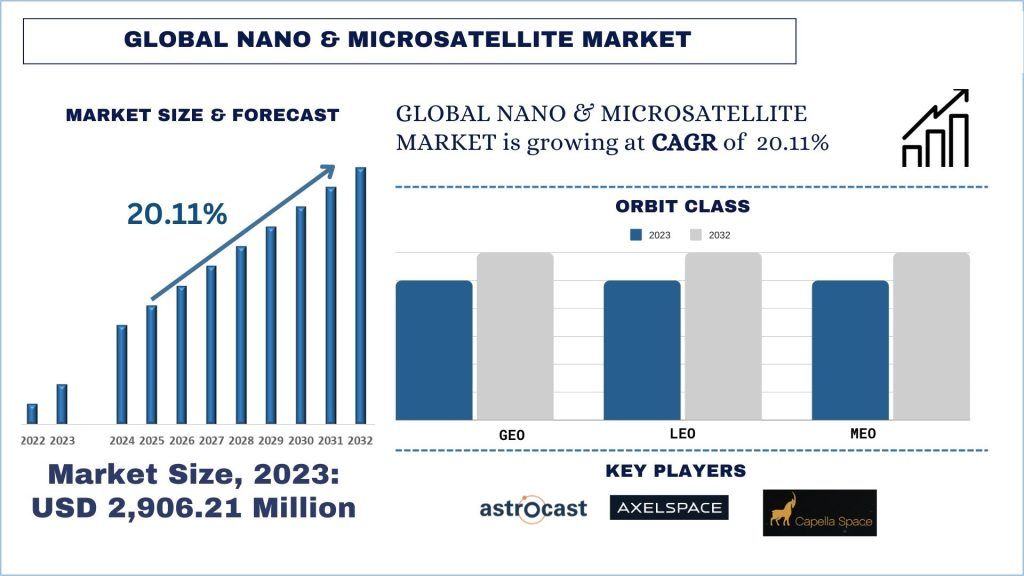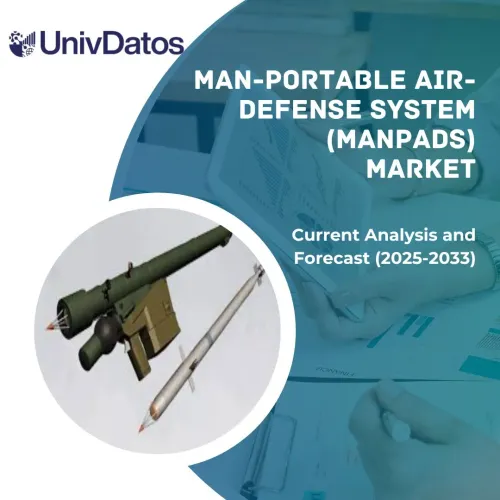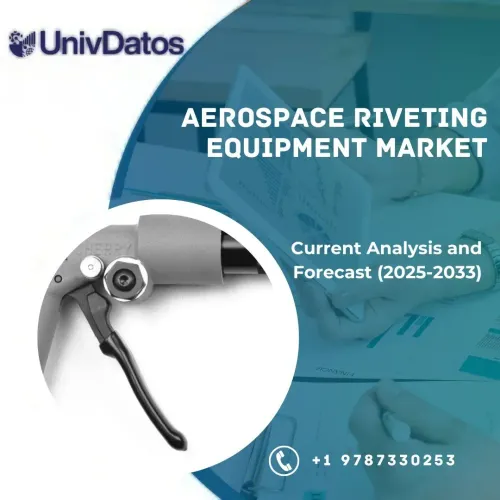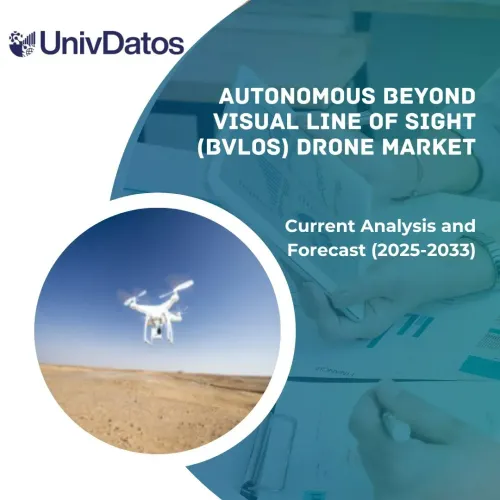- Startseite
- Über uns
- Industrie
- Dienstleistungen
- Lesen
- Kontaktieren Sie uns
Nano- & Mikrosatellitenmarkt: Aktuelle Analyse und Prognose (2024-2032)
Schwerpunkt auf Anwendung (Kommunikation, Erdbeobachtung, Navigation, Weltraumbeobachtung, Sonstige); Nach Orbitklasse (GEO, LEO, MEO), Nach Endverbraucher (Elektrisch, Gasförmiger flüssiger Kraftstoff); Nach Anwendung (Motorkomponente, Raumfahrtkomponente, Strukturkomponente) und Regionen (Nordamerika (Die USA, Kanada, Übriges Nordamerika), Europa (Deutschland, Großbritannien, Frankreich, Italien, Spanien, Übriges Europa), Asien-Pazifik (China, Japan, Indien, Übriges Asien-Pazifik), Übrige Welt)
Globale Marktgröße & Prognose für Nano- & Mikrosatelliten
Der globale Markt für Nano- & Mikrosatelliten wurde im Jahr 2023 auf 2.906,21 Millionen USD geschätzt und wird voraussichtlich mit einer starken CAGR von rund 20,11 % im Prognosezeitraum (2024-2032) wachsen, was auf die steigende Nachfrage nach Nano- & Mikrosatelliten in der Raumfahrzeugindustrie weltweit zurückzuführen ist.
Globale Marktanalyse für Nano- & Mikrosatelliten
Nano- und Mikrosatelliten sind kleinere Satelliten, die die Erde umkreisen, um Erdbeobachtung, Satellitenkommunikation, Navigation usw. zu ermöglichen. Diese Satelliten sind von kleinerer Größe, wobei Nanosatelliten zwischen 1 und 10 kg und Mikrosatelliten zwischen 10 kg und 100 kg wiegen. Diese Satelliten sind für zeitlich begrenzte Operationen wie Erdbeobachtung, Telekommunikation, wissenschaftliche Forschung und Technologiedemonstration äußerst kostengünstig.
Der globale Markt für Nano- & Mikrosatelliten wurde im Jahr 2023 auf 2.906,21 Millionen USD geschätzt und wird voraussichtlich mit einer starken CAGR von rund 20,11 % im Prognosezeitraum (2024-2032) wachsen. Einer der Faktoren, der maßgeblich zum Marktwachstum beigetragen hat, ist der zunehmende Fokus auf die Erdbeobachtung durch Nano- und Mikrosatelliten. Da diese Satelliten ein Gleichgewicht zwischen Kosten und Leistung für eine breite Palette von Anwendungen wie Satellitennavigationskonstellationen oder Satellitenkommunikation bieten, sind die Satellitentypen zu einer lukrativen Wahl geworden.
So kündigte Polen beispielsweise im Jahr 2021 den Start seines ersten Mikrosatelliten an, der sich auf die Bereitstellung von Dienstleistungen im Zusammenhang mit der Erdbeobachtung konzentriert. Der Satellit namens Eagle Eye, ein 50 kg schwerer Satellit, basiert auf der von Creotech Instruments entwickelten HyperSat-Mikrosatellitenplattform.
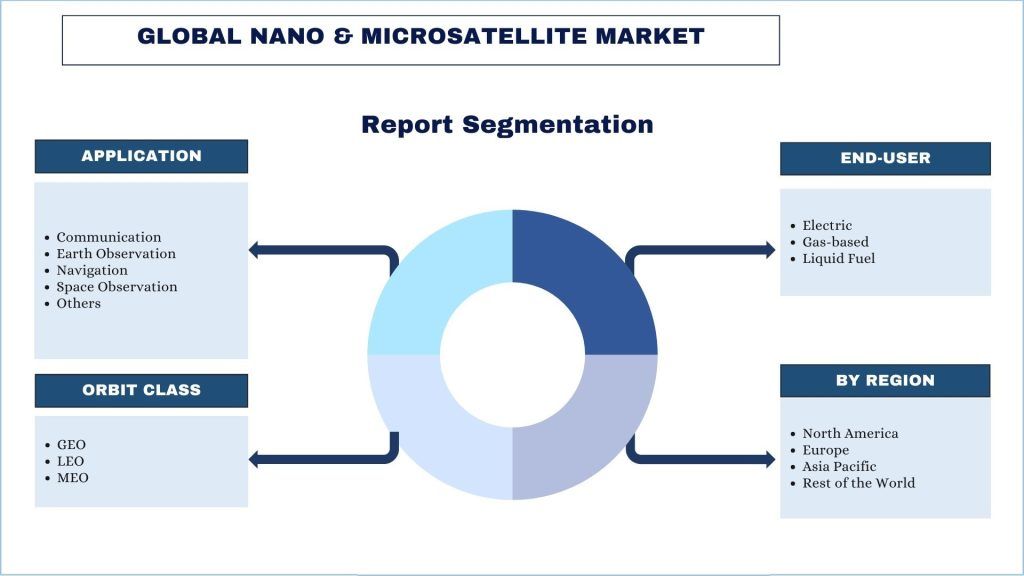
Globale Markttrends für Nano- & Mikrosatelliten
Dieser Abschnitt befasst sich mit den wichtigsten Markttrends, die die verschiedenen Segmente des globalen Marktes für Nano- & Mikrosatelliten beeinflussen, wie sie von unserem Team von Forschungsexperten identifiziert wurden.
Steigende Nachfrage nach Navigations- und Erdbeobachtungskonstellationen zur Förderung des zukünftigen Marktes
Die Navigationskonstellation hat sich für viele Länder auf der ganzen Welt zu einer entscheidenden Fähigkeit entwickelt. Einige Länder betreiben bereits eine riesige Navigationskonstellation mit erweiterten Fähigkeiten, die große Teile der Erde abdeckt. Der Bedarf an einer Verbesserung der Navigation durch mehrere Schwellenländer hat jedoch den Bedarf an Navigationskonstellationen weiter erhöht. Länder wie Indien, Indonesien, Polen, Brasilien usw. gehören zu den Schwellenländern, die ihre Absicht bekundet haben, in den kommenden Jahren ihre Navigationskonstellation zu initiieren/starten.
So erhielten Blacksky Technology Inc. und Thales Alenia Space im Jahr 2024 von der indonesischen Regierung einen Auftrag zur Lieferung von Gen3-Erdbeobachtungssatelliten mit Bodenstationsfunktionen und Flugbetriebsunterstützung. Die Gesamtkosten des Projekts belaufen sich auf 50 Millionen USD für die Lieferung von 3 Satelliten in den kommenden Jahren.
In einem anderen Fall kündigte Griechenland an, 70 Millionen USD in eine Erdbeobachtungs-Mikrosatellitenkonstellation zu investieren. Im Jahr 2023 wurden die drei Unternehmen OHB Hellas, Thales Hellas und SITAEL Hellas für die Studienphase der Projektentwicklung ausgewählt.
In Anbetracht der steigenden Nachfrage nach Navigations- und Erdbeobachtungssatellitenkonstellationen auf der ganzen Welt wird erwartet, dass die Nachfrage nach Nano- & Mikrosatelliten in der jeweiligen Kategorie ein schnelles Wachstum erfährt, was in den kommenden Jahren das Wachstum des Marktes ankurbeln wird.
Es wird erwartet, dass Nordamerika im Prognosezeitraum den größten Marktanteil halten wird
Nordamerika hält den größten Marktanteil am Markt für Nano- und Mikrosatelliten. Einer der Faktoren, die zum Marktwachstum beitragen, ist das Vorhandensein einer riesigen Raumfahrtindustrie, die sich auf Satellitenstarts konzentriert, sowohl militärische als auch kommerzielle Missionen. Darüber hinaus ist die Region auch einer der Vorreiter bei Satellitenstarts mit langjähriger Erfahrung in der Satellitenherstellung und Starttechnologie.
Es gibt mehrere andere Faktoren, die die Expansion des Nano- und Mikrosatellitenmarktes in der nordamerikanischen Region unterstützen, darunter technologische Innovationen, staatliche Unterstützung, Marktnachfrage nach Satellitendiensten regional und weltweit, Bildungseinrichtungen, die in Satellitentechnologie und -forschung investieren, und förderliche regulatorische Bestimmungen. Regierungsbehörden wie das US-Verteidigungsministerium und die NASA haben maßgeblich zur Entwicklung und Förderung des Einsatzes von Nano- und Mikrosatelliten in verschiedenen militärischen und kommerziellen Luft- und Raumfahrtanwendungen beigetragen. Darüber hinaus bieten die jeweiligen Organisationen Verträge und regulatorische Unterstützung für das Satellitenherstellungsökosystem, damit es in der Region florieren kann.
Im Jahr 2024 erhielt die NASA einen Vertrag im Wert von 6 Milliarden USD an Kongsberg NanoAvionics US LLC und drei weitere Unternehmen im Rahmen ihres Rapid Spacecraft Acquisition IV (Rapid IV) On-Ramp III-Vertrags. Der Vertrag im Rahmen des Rapid IV-Programms würde Regierungsbehörden dabei helfen, Weltraummissionen effizient durchzuführen, indem sie Raumfahrzeuge und Satellitensysteme beschaffen.
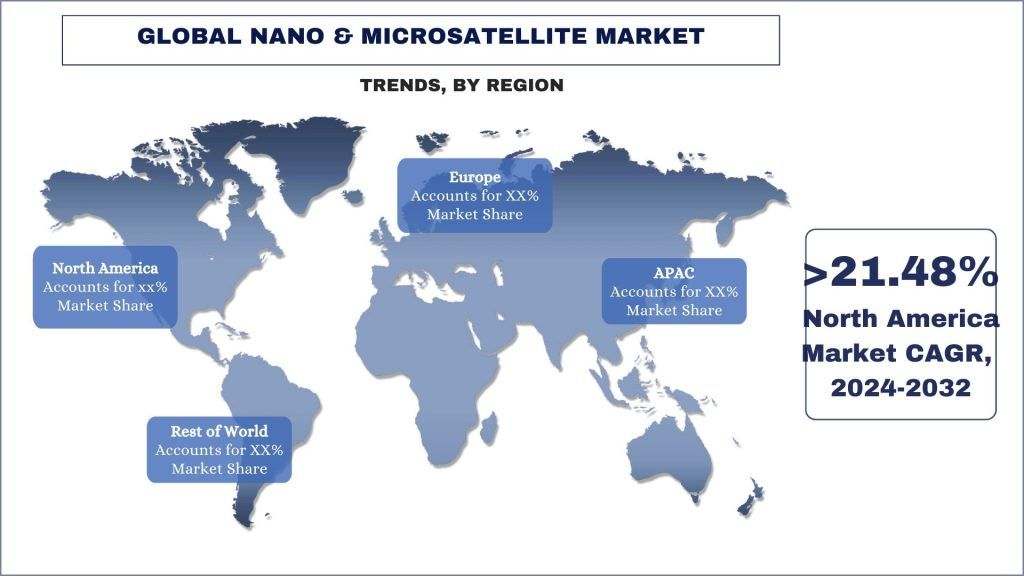
Globale Branchenübersicht für Nano- & Mikrosatelliten
Der globale Markt für Nano- & Mikrosatelliten ist wettbewerbsintensiv und fragmentiert, mit der Präsenz mehrerer globaler und internationaler Marktteilnehmer. Die wichtigsten Akteure verfolgen verschiedene Wachstumsstrategien, um ihre Marktpräsenz zu verbessern, wie z. B. Partnerschaften, Vereinbarungen, Kooperationen, neue Produkteinführungen, geografische Expansionen sowie Fusionen und Übernahmen. Einige der wichtigsten Akteure auf dem Markt sind Astrocast, Axelspace Corporation, Capella Space Corp., China Aerospace Science and Technology Corporation, German Orbital System, GOMSpace ApS, ICEYS Ltd, LeoStella LLC, Planet Lab PBC, L3harris Technologies.
Globale Marktnachrichten für Nano- & Mikrosatelliten
- Im Jahr 2023 startete Indien sieben Satelliten aus Singapur in die niedrige Erdumlaufbahn. Der primäre Satellit hatte ein Gewicht von 360 kg, während der Rest der Satelliten in die Kategorie der Mikrosatelliten fiel.
- Im Jahr 2022 kündigte Großbritannien den Start der Orbex Prime "Öko-Rakete" von einer abgelegenen Startrampe in den Highlands von Schottland an. Das Trägersystem würde verwendet, um in den kommenden Jahren den Großteil der Nanosatelliten in den Weltraum zu starten.
Globale Marktabdeckung für Nano- & Mikrosatelliten
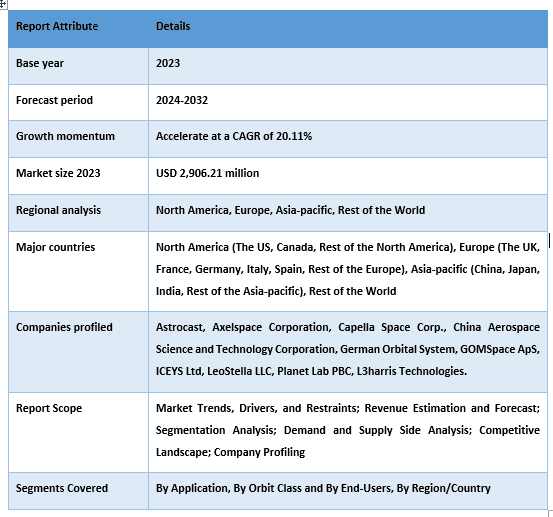
Gründe für den Kauf dieses Berichts:
- Die Studie beinhaltet eine Marktdimensionierungs- und Prognoseanalyse, die von authentifizierten wichtigen Branchenexperten validiert wurde.
- Der Bericht bietet einen schnellen Überblick über die Gesamtleistung der Branche auf einen Blick.
- Der Bericht enthält eine detaillierte Analyse der wichtigsten Branchenkollegen mit einem primären Fokus auf die wichtigsten Finanzkennzahlen des Unternehmens, Produktportfolios, Expansionsstrategien und aktuelle Entwicklungen.
- Detaillierte Untersuchung der Treiber, Beschränkungen, wichtigsten Trends und Chancen, die in der Branche vorherrschen.
- Die Studie deckt den Markt umfassend über verschiedene Segmente hinweg ab.
- Tiefgehende regionale Analyse der Branche.
Anpassungsoptionen:
Der globale Markt für Nano- & Mikrosatelliten kann weiter an die Anforderungen oder ein anderes Marktsegment angepasst werden. Darüber hinaus versteht UMI, dass Sie möglicherweise Ihre eigenen geschäftlichen Bedürfnisse haben. Nehmen Sie daher Kontakt mit uns auf, um einen Bericht zu erhalten, der Ihren Anforderungen vollständig entspricht.
Inhaltsverzeichnis
Forschungsmethodik für die globale Nano- & Mikrosatellitenmarkt-Analyse (2024-2032)
Die Analyse des historischen Marktes, die Schätzung des aktuellen Marktes und die Prognose des zukünftigen Marktes des globalen Nano- & Mikrosatellitenmarktes waren die drei wichtigsten Schritte, die unternommen wurden, um die Einführung von globalen Nano- & Mikrosatelliten in wichtigen Regionen weltweit zu erstellen und zu analysieren. Es wurde eine umfassende Sekundärforschung durchgeführt, um die historischen Marktzahlen zu sammeln und die aktuelle Marktgröße zu schätzen. Zweitens wurden zahlreiche Erkenntnisse und Annahmen berücksichtigt, um diese Erkenntnisse zu validieren. Darüber hinaus wurden ausführliche Primärinterviews mit Branchenexperten entlang der Wertschöpfungskette des globalen Nano- & Mikrosatellitenmarktes geführt. Nach der Annahme und Validierung der Marktzahlen durch Primärinterviews haben wir einen Top-Down-/Bottom-Up-Ansatz verwendet, um die vollständige Marktgröße zu prognostizieren. Danach wurden Marktaufschlüsselungs- und Datentriangulationsmethoden angewendet, um die Marktgröße von Segmenten und Untersegmenten der Branche zu schätzen und zu analysieren. Die detaillierte Methodik wird im Folgenden erläutert:
Analyse der historischen Marktgröße
Schritt 1: Eingehende Untersuchung von Sekundärquellen:
Es wurde eine detaillierte Sekundärstudie durchgeführt, um die historische Marktgröße des globalen Nano- & Mikrosatellitenmarktes durch unternehmensinterne Quellen wie Geschäftsberichte & Finanzberichte, Performance-Präsentationen, Pressemitteilungen usw. und externe Quellen wie Fachzeitschriften, Nachrichten & Artikel, Regierungsveröffentlichungen, Wettbewerberveröffentlichungen, Branchenberichte, Datenbanken von Drittanbietern und andere glaubwürdige Veröffentlichungen zu erhalten.
Schritt 2: Marktsegmentierung:
Nachdem wir die historische Marktgröße des globalen Nano- & Mikrosatellitenmarktes erhalten hatten, führten wir eine detaillierte Sekundäranalyse durch, um historische Markteinblicke und Anteile für verschiedene Segmente & Untersegmente für wichtige Regionen zu sammeln. Die wichtigsten Segmente, die im Bericht enthalten sind, sind nach Anwendung, nach Orbitklasse und nach Endverbrauchern. Weiterhin wurden regionale/länderspezifische Analysen durchgeführt, um die allgemeine Akzeptanz von Testmodellen in dieser Region zu bewerten.
Schritt 3: Faktorenanalyse:
Nachdem wir die historische Marktgröße verschiedener Segmente und Untersegmente ermittelt hatten, führten wir eine detaillierte Faktorenanalyse durch, um die aktuelle Marktgröße des globalen Nano- & Mikrosatellitenmarktes zu schätzen. Darüber hinaus führten wir eine Faktorenanalyse unter Verwendung abhängiger und unabhängiger Variablen wie nach Anwendung, nach Orbitklasse und nach Endverbrauchern im globalen Nano- & Mikrosatellitenmarkt durch. Es wurde eine gründliche Analyse für Angebots- und Nachfrageszenarien unter Berücksichtigung der wichtigsten Partnerschaften, Fusionen und Übernahmen, Geschäftsausweitungen und Produkteinführungen im globalen Nano- & Mikrosatellitenmarktsektor auf der ganzen Welt durchgeführt.
Aktuelle Marktgrößenschätzung & Prognose
Aktuelle Marktgrößenbestimmung: Basierend auf verwertbaren Erkenntnissen aus den oben genannten 3 Schritten haben wir die aktuelle Marktgröße, die wichtigsten Akteure im globalen Nano- & Mikrosatellitenmarkt und die Marktanteile der Segmente ermittelt. Alle erforderlichen prozentualen Anteile und Marktaufteilungen wurden unter Verwendung des oben genannten sekundären Ansatzes ermittelt und durch Primärinterviews verifiziert.
Schätzung & Prognose: Für die Marktschätzung und -prognose wurden verschiedenen Faktoren Gewichte zugewiesen, darunter Treiber & Trends, Beschränkungen und Chancen, die den Stakeholdern zur Verfügung stehen. Nach der Analyse dieser Faktoren wurden relevante Prognosetechniken, d. h. der Top-Down-/Bottom-Up-Ansatz, angewendet, um die Marktprognose für 2032 für verschiedene Segmente und Untersegmente in den wichtigsten Märkten weltweit zu erstellen. Die Forschungsmethodik zur Schätzung der Marktgröße umfasst:
- Die Marktgröße der Branche in Bezug auf Umsatz (USD) und die Akzeptanzrate des globalen Nano- & Mikrosatellitenmarktes in den wichtigsten Märkten im Inland
- Alle prozentualen Anteile, Aufteilungen und Aufschlüsselungen von Marktsegmenten und Untersegmenten
- Wichtige Akteure im globalen Nano- & Mikrosatellitenmarkt in Bezug auf die angebotenen Produkte. Auch die Wachstumsstrategien, die von diesen Akteuren angewendet werden, um in dem schnell wachsenden Markt zu konkurrieren.
Validierung von Marktgröße und -anteil
Primärforschung: Es wurden ausführliche Interviews mit den wichtigsten Meinungsführern (Key Opinion Leaders, KOLs) geführt, darunter Führungskräfte der obersten Ebene (CXO/VPs, Vertriebsleiter, Marketingleiter, Betriebsleiter, Regionalleiter, Landesleiter usw.) in den wichtigsten Regionen. Die wichtigsten Ergebnisse wurden dann zusammengefasst und eine statistische Analyse durchgeführt, um die aufgestellte Hypothese zu beweisen. Die Erkenntnisse aus der Primärforschung wurden mit den Erkenntnissen aus der Sekundärforschung zusammengeführt, wodurch Informationen in verwertbare Erkenntnisse umgewandelt wurden.
Aufteilung der primären Teilnehmer in verschiedenen Regionen
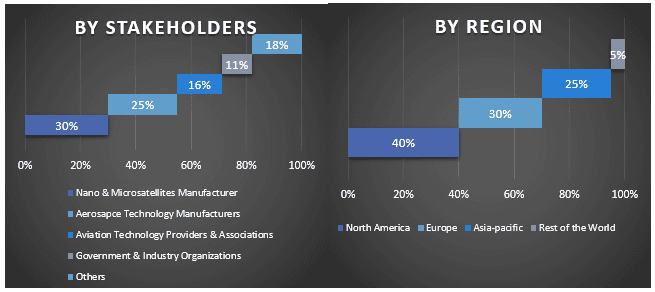
Markttechnik
Die Datentriangulationstechnik wurde verwendet, um die allgemeine Marktschätzung abzuschließen und präzise statistische Zahlen für jedes Segment und Untersegment des globalen Nano- & Mikrosatellitenmarktes zu erhalten. Die Daten wurden nach dem Studium verschiedener Parameter und Trends in der Anwendung, nach Orbitklasse und nach Endverbrauchern im globalen Nano- & Mikrosatellitenmarkt in mehrere Segmente und Untersegmente aufgeteilt.
Das Hauptziel der Global Nano & Microsatellite Market Study
Die aktuellen & zukünftigen Markttrends des globalen Nano- & Mikrosatellitenmarktes wurden in der Studie genau bestimmt. Investoren können strategische Einblicke gewinnen, um ihre Entscheidungen für Investitionen auf der Grundlage der in der Studie durchgeführten qualitativen und quantitativen Analyse zu treffen. Aktuelle und zukünftige Markttrends bestimmten die allgemeine Attraktivität des Marktes auf regionaler Ebene und boten den Industrieteilnehmern eine Plattform, um den unerschlossenen Markt zu nutzen und von einem First-Mover-Vorteil zu profitieren. Weitere quantitative Ziele der Studien sind:
- Analysieren Sie die aktuelle und prognostizierte Marktgröße des globalen Nano- & Mikrosatellitenmarktes in Bezug auf den Wert (USD). Analysieren Sie auch die aktuelle und prognostizierte Marktgröße verschiedener Segmente und Untersegmente.
- Die Segmente in der Studie umfassen die Bereiche Anwendung, Orbitklasse und Endverbraucher.
- Definieren und analysieren Sie den regulatorischen Rahmen für den globalen Nano- & Mikrosatelliten
- Analysieren Sie die Wertschöpfungskette, die mit der Anwesenheit verschiedener Intermediäre verbunden ist, und analysieren Sie das Kunden- und Wettbewerberverhalten der Branche.
- Analysieren Sie die aktuelle und prognostizierte Marktgröße des globalen Nano- & Mikrosatellitenmarktes für die wichtigsten Regionen.
- Zu den wichtigsten Ländern der in dem Bericht untersuchten Regionen gehören Nordamerika (die USA, Kanada und das übrige Nordamerika), Europa (das Vereinigte Königreich, Frankreich, Deutschland, Italien, Spanien, das übrige Europa), der asiatisch-pazifische Raum (China, Japan, Indien, der übrige asiatisch-pazifische Raum), der Rest der Welt
- Unternehmensprofile des globalen Nano- & Mikrosatellitenmarktes und die Wachstumsstrategien, die von den Marktakteuren angewendet werden, um sich in dem schnell wachsenden Markt zu behaupten.
- Tiefgehende regionale Analyse der Branche
Häufig gestellte Fragen FAQs
F1: Wie groß ist die aktuelle Marktgröße und das Wachstumspotenzial des globalen Nano- & Mikrosatellitenmarktes?
F2: Was sind die treibenden Faktoren für das Wachstum des globalen Nano- & Mikrosatelliten-Marktes?
F3: Welches Segment hat den größten Anteil am globalen Nano- & Mikrosatellitenmarkt nach Anwendung?
F4: Welche Region wird den globalen Nano- & Mikrosatellitenmarkt dominieren?
Verwandt Berichte
Kunden, die diesen Artikel gekauft haben, kauften auch

